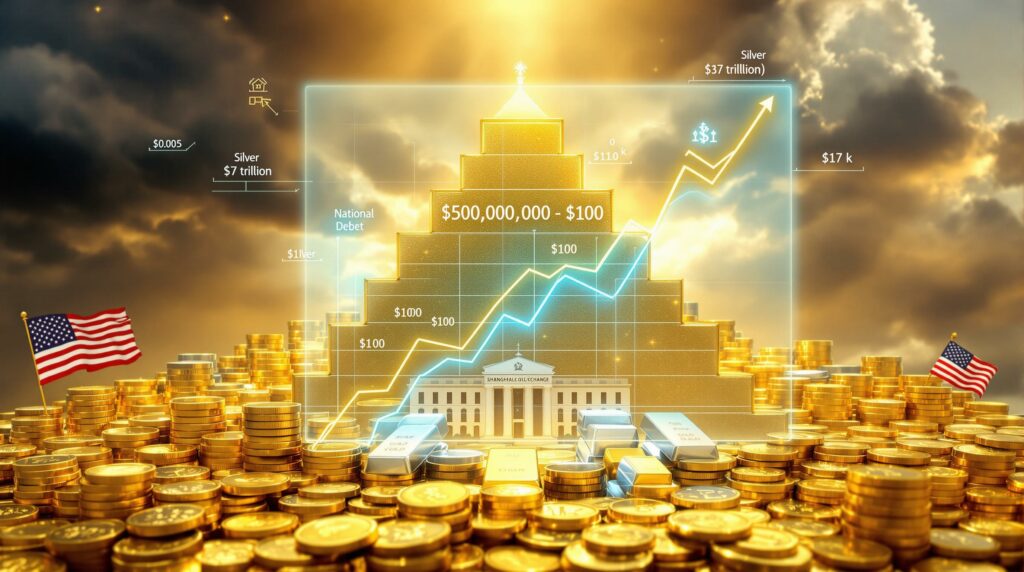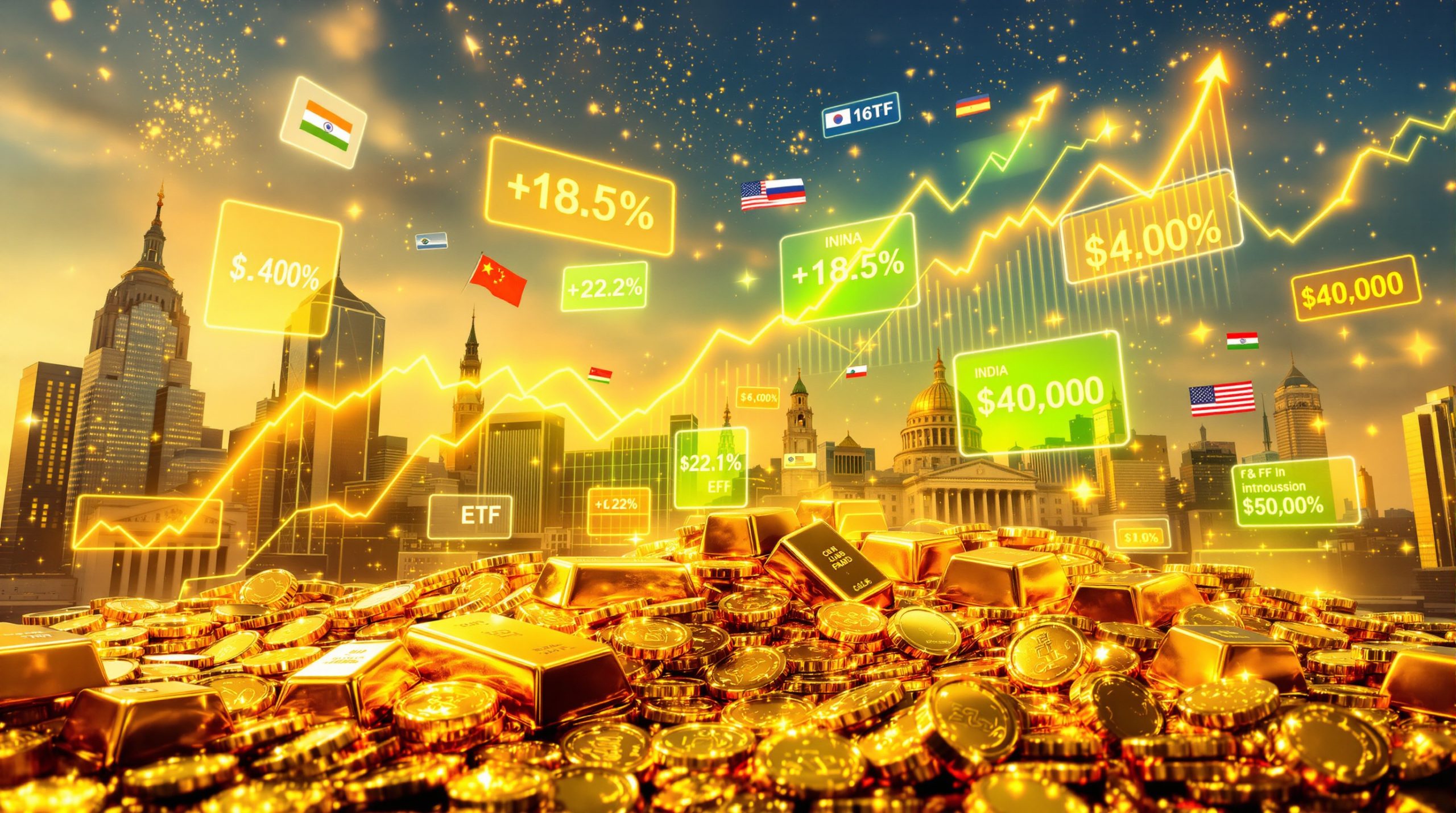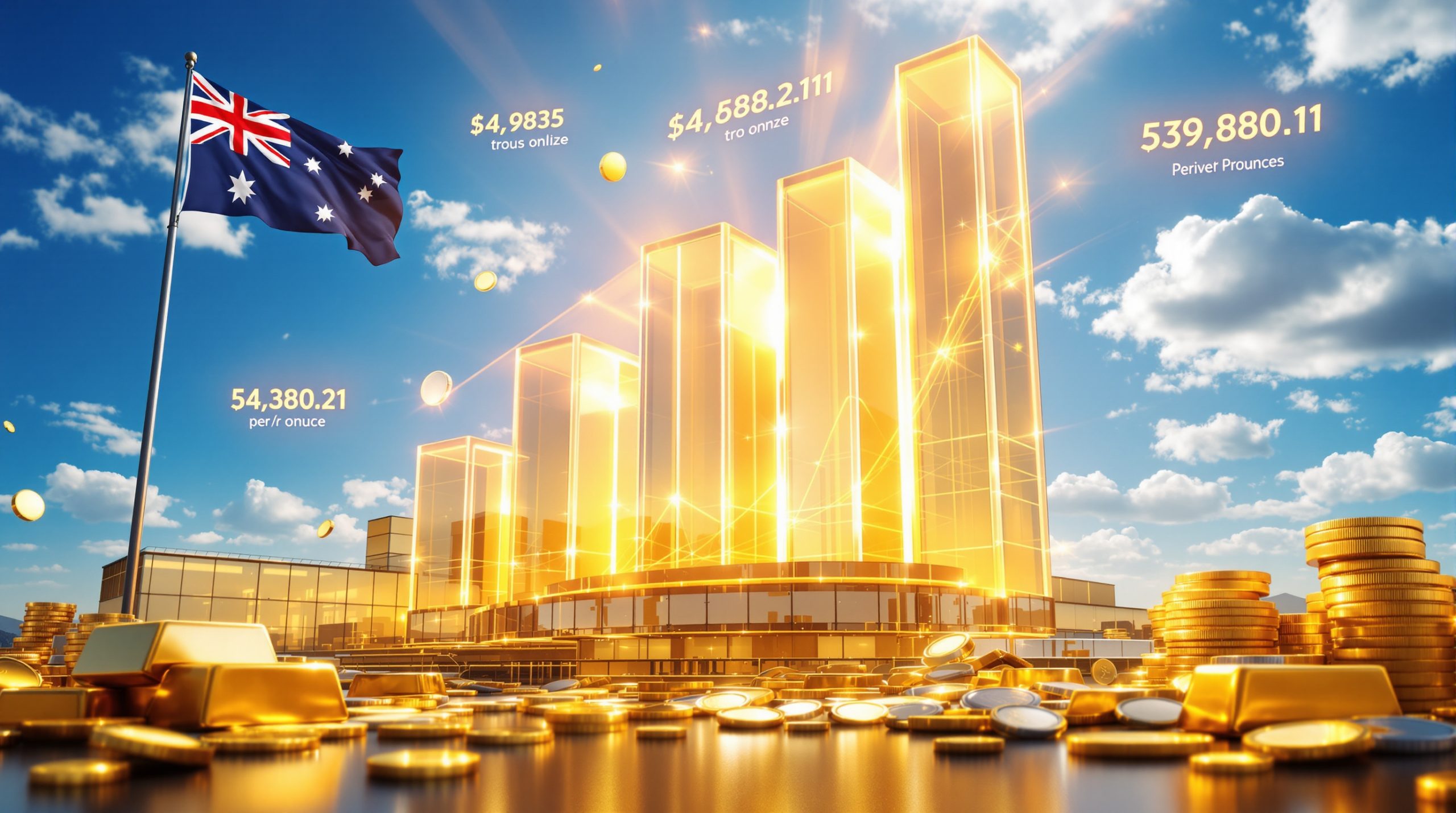The Precious Metals Momentum: Understanding Gold and Silver Market Analysis
Gold has steadily climbed toward record highs while silver continues to gain significant momentum. With each passing day, market participants are witnessing unprecedented movements in precious metals markets that demand thorough analysis. For investors seeking clarity amid inflation and economic uncertainty, understanding the current drivers behind these markets has never been more critical.
What's Driving the Current Precious Metals Rally?
The precious metals market has demonstrated remarkable resilience and upward momentum in recent months, with gold reaching approximately $3,340 per ounce and silver hovering around $37.44. This impressive performance has caught the attention of both seasoned investors and newcomers to the precious metals space.
Recent Price Performance
Gold has been the standout performer, adding approximately $7 in recent trading sessions while maintaining its position above the psychologically important $3,300 level. Meanwhile, silver has stabilized around $37.44 per ounce, representing a significant year-to-date gain. Perhaps most surprising has been platinum's unexpected surge, which has outpaced analysts' expectations in recent weeks.
"The precious metals market is experiencing a perfect storm of macroeconomic catalysts that continue to drive prices higher. This isn't just a short-term spike – the fundamental factors supporting this rally appear increasingly sustainable." – Market analyst perspective
The technical indicators suggest continued strength, with gold's price action forming consistently higher lows and higher highs – the classic definition of an uptrend. Trading volumes have remained robust, indicating genuine market participation rather than speculative froth.
Macroeconomic Catalysts
The Federal Reserve has pivoted dramatically from its previous hawkish stance, with clear signals that interest rate cuts are imminent. Federal Reserve Governor Daly recently indicated that "four rate cuts here sooner rather than later" could be expected, setting the stage for a potentially accelerated easing cycle.
This shift in monetary policy has placed significant pressure on the U.S. dollar, with the Dollar Index currently sitting around 98.60 and showing signs of vulnerability. Many market analysts now project potential dollar weakness that could push the index toward the 90 level in coming months.
Key macroeconomic factors influencing precious metals include:
- Interest rate trajectory: Lower rates reduce the opportunity cost of holding non-yielding assets like gold
- Inflation concerns: Despite official statistics, real-world inflation continues to erode purchasing power
- Economic uncertainty: Slowing growth metrics across major economies
- Central bank policies: Quantitative easing measures flooding markets with liquidity
How Are Geopolitical Tensions Affecting Precious Metals Markets?
Geopolitical tensions have historically provided strong tailwinds for precious metals markets, and the current environment is proving this relationship once again. The complex interplay between East and West is reshaping traditional market dynamics in profound ways.
Global Power Dynamics
The intensifying economic competition between Eastern and Western powers has created persistent market uncertainty that typically favors safe-haven assets. This uncertainty is manifesting in the competition between major trading hubs, with Shanghai, London, and COMEX all vying for dominance in precious metals price discovery.
Thomas Pilla, President of Pilla Investment Group, notes: "What's going on with Shanghai, London, and the Comex? That's part of a larger economic rivalry playing out globally."
Eastern nations have strategically positioned themselves by accumulating substantial precious metals reserves over the past decade. This accumulation appears aimed at reducing dollar dependence while establishing alternative financial mechanisms for international trade.
The changing dynamics in price discovery mechanisms include:
- Increased influence of Shanghai Gold Exchange pricing
- Growing physical delivery demands across exchanges
- Divergence between paper and physical metal prices
- Strategic reserve building by central banks globally
Financial System Vulnerabilities
Market analysts have expressed growing concerns about the substantial short positions held by Western financial institutions in precious metals markets. These positions potentially create systemic risks if prices surge dramatically, potentially triggering a short squeeze scenario that could amplify price movements.
The precious metals market has faced persistent allegations of price manipulation, which has affected investor confidence and contributed to market inefficiencies. These concerns have prompted increased regulatory scrutiny and calls for greater transparency across global exchanges.
"The amount of shorts on the gold and silver markets in the United States banks is astronomical right now," according to Thomas Pilla, highlighting potential vulnerabilities in market structure.
What Are Expert Price Projections for Gold and Silver?
While price projections should always be viewed with appropriate skepticism, analyzing expert forecasts provides valuable insight into potential market trajectories. Current projections for precious metals range from conservative estimates to bold predictions of unprecedented price levels.
Short-Term Forecasts (Next 6 Months)
Gold appears poised for continued strength in the immediate future, with technical analysis suggesting a potential move toward $4,000 in the next upward movement. By January, some market analysts project gold could reach approximately $5,000 per ounce if current fundamental drivers remain in place.
Silver, often referred to as "gold on steroids" due to its higher volatility, could potentially reach the psychologically significant $50 level by early next year according to multiple forecasts. This would represent a substantial percentage gain from current levels.
Medium-Term Projections (12-24 Months)
Looking further ahead, more aggressive projections suggest gold could potentially reach $7,500 within one year under scenarios of accelerated monetary debasement and geopolitical instability. Within the same timeframe, silver could potentially achieve the $100 mark, representing a more than 160% gain from current levels.
Within a two-year horizon, some analysts believe gold could test the $10,000 level, particularly if the global monetary system undergoes significant restructuring or if confidence in fiat currencies deteriorates substantially.
Precious Metals Price Projections
| Metal | Current Price | 6-Month Projection | 12-Month Projection | 24-Month Projection |
|---|---|---|---|---|
| Gold | ~$3,340 | $4,000-$5,000 | $7,000-$7,500 | $8,000-$10,000 |
| Silver | ~$37.44 | $45-$50 | $85-$100 | $120-$150 |
| Platinum | Varies | Moderate gains | Potential breakout | Significant appreciation |
Catalysts for These Projections
These ambitious price targets are predicated on several potential catalysts:
- An accelerated Federal Reserve rate cutting cycle that could begin with larger-than-expected initial cuts
- Continued dollar weakness as global central banks diversify reserves away from USD
- Growing national debt concerns as debt service costs consume an increasing share of the federal budget
- Potential shifts in the global monetary system, possibly including partial commodity backing for major currencies
Disclaimer: These projections represent expert opinions rather than guaranteed outcomes. Investors should use such forecasts as one input among many when making investment decisions and should not rely solely on price predictions when allocating capital.
Why Is National Debt a Critical Factor for Precious Metals Investors?
The relationship between national debt and precious metals prices forms one of the most reliable correlations in financial markets. Understanding this connection provides invaluable context for investment strategies.
Current Debt Situation
The U.S. national debt has surpassed $37 trillion and continues to grow at an accelerating pace. This unprecedented debt load has pushed the debt-to-GDP ratio to historically unsustainable levels, creating structural pressures on the monetary system.
Perhaps most concerning is the declining productivity of this debt spending. As Pilla notes, "We are spending $3.50 to create $1 of GDP," representing a dramatic deterioration in the efficiency of government spending. This inefficiency suggests that even higher levels of debt may be required to maintain economic growth.
The potential fiscal policy changes under the current administration could further impact debt trajectories, with implications for monetary policy and precious metals markets.
Historical Context
The abandonment of the gold standard in 1971 under President Nixon marked a pivotal moment for both the monetary system and precious metals. Since that transition to a purely fiat currency system, the correlation between expanding debt and rising precious metals prices has been remarkably consistent.
The purchasing power of the dollar has eroded substantially over decades, while gold has maintained and increased its purchasing power. This divergence highlights gold's role as a store of value during periods of currency debasement.
Historical data reveals a clear pattern:
- 1971-1980: Gold rose from $35 to $850 as debt expanded
- 2000-2011: Gold rose from $250 to $1,900 during another debt expansion phase
- 2018-Present: Gold has moved from $1,200 to over $3,300 amid unprecedented debt growth
Long-Term Implications
The current debt trajectory suggests several potential long-term implications that precious metals investors should consider:
- Currency devaluation scenarios: Historical precedent suggests that excessive debt is typically resolved through currency devaluation rather than fiscal discipline
- Inflation risks: Despite official statistics suggesting controlled inflation, real-world price increases in essential goods and services continue to erode purchasing power
- Global financial power shifts: Nations with stronger fiscal positions and substantial gold reserves may gain increased influence in international monetary affairs
"Honestly it's just… debt, debt, more debt, that's all you have to pay attention to… As long as the debt load continues to go higher, gold and silver is going to go higher," explains Thomas Pilla, highlighting this critical relationship.
What's the Optimal Allocation Strategy for Precious Metals Investors?
Determining the right allocation strategy for precious metals requires balancing multiple factors, including risk tolerance, investment timeline, and financial objectives. While individual circumstances vary, several approaches have demonstrated effectiveness across different market conditions.
Diversification Approach
Many experienced precious metals investors advocate for an equal allocation strategy, dividing investments into roughly equal portions: 33% gold, 33% silver, and 33% platinum. This balanced approach provides exposure to each metal's unique market dynamics while reducing concentration risk.
The benefits of this diversification include:
- Reduced volatility: Gold's stability balances silver's higher volatility
- Exposure to different industrial demands: Silver and platinum have significant industrial applications beyond monetary use
- Capturing different market cycles: Each metal tends to outperform at different points in the economic cycle
Thomas Pilla recommends: "The smart play would be if you can just split it equally 33% across the board and take the brain work out of it," highlighting the simplicity and effectiveness of this approach.
Single-Metal Focus Considerations
Investors may choose to concentrate their holdings in a single metal based on specific objectives:
-
Gold offers superior security and stability, often referred to as the "Cadillac" choice for wealth preservation. Its high value-to-weight ratio makes storage more practical, and its market typically experiences lower volatility.
-
Silver presents potentially higher percentage returns due to its smaller market size and greater industrial demand. The ongoing silver market transformation has attracted significant investor attention. However, its lower value-to-weight ratio creates additional storage considerations.
-
Platinum and other platinum group metals offer unique exposure to automotive and industrial catalysts, with more specialized market dynamics.
"If you put money into [silver] instead of gold, that'd be just fine… But I'm more secure holding gold than I am silver," notes Pilla, highlighting the psychological comfort that gold's stability provides many investors.
Implementation Strategy
Successful precious metals investing typically involves consistent implementation rather than attempting to time market movements perfectly:
- Dollar-cost averaging through regular purchases helps mitigate timing risk and allows accumulation through price cycles
- Physical possession vs. allocated storage options should be evaluated based on security needs, insurance costs, and accessibility requirements
- Avoiding emotional reactions to short-term price movements is crucial for long-term success
For most investors, building positions steadily over time while focusing on the fundamental drivers rather than daily price fluctuations provides the most reliable path to long-term success.
How Should Young Investors Approach Precious Metals Markets?
Young investors have a unique advantage when approaching precious metals markets: time. Their longer investment horizon allows them to benefit from compound appreciation while weathering short-term volatility with greater ease.
Key Metrics to Monitor
Young investors should focus on fundamental metrics rather than technical indicators or short-term price movements:
- National debt trajectory: The most reliable correlation with precious metals prices over time
- Federal Reserve policy shifts: Particularly regarding interest rates and balance sheet activities
- Physical premiums over spot prices: Indicating supply/demand imbalances in physical markets
- Central bank buying patterns: Reflecting institutional attitudes toward precious metals
"As long as the debt load continues to go higher, gold and silver is going to go higher," emphasizes Pilla, pointing to the most consistent long-term driver.
Long-Term Perspective
For younger investors, cultivating patience represents perhaps the most valuable attribute for successful precious metals investing:
- Wealth preservation focus: Understanding precious metals primarily as insurance against monetary system risks rather than speculative vehicles
- Consistent accumulation: Regularly adding to positions regardless of short-term price movements
- Avoiding speculation: Resisting the temptation to trade frequently or use leverage
"Just buy it and stick it away… you're going to make a lot of money, you know, if you look out a year from now or two years from now," advises Pilla, emphasizing the value of a patient approach.
Educational Resources
Young investors should prioritize developing financial literacy around monetary history and precious metals markets:
- Understanding the fundamental differences between fiat currency and sound money
- Studying previous monetary system transitions throughout history
- Learning about global financial systems and interconnections
- Developing knowledge about physical precious metals characteristics and verification
Resources such as academic economic histories, central bank publications, and Kitco news provide valuable educational foundations for developing informed perspectives.
What Risks Should Precious Metals Investors Be Aware Of?
While precious metals offer significant potential benefits, prudent investors must understand and prepare for various risks that could impact their holdings. Acknowledging these risks allows for more realistic expectations and appropriate position sizing.
Market Manipulation Concerns
Concerns about price suppression in precious metals markets have persisted for decades, with allegations that large financial institutions use short positions and paper market mechanisms to artificially depress prices.
"The amount of shorts on the gold and silver markets in the United States banks, it's astronomical right now," notes Pilla, highlighting potential market structure issues.
These concerns include:
- Potential disconnection between paper markets (futures) and physical markets
- Concentration of short positions among a small number of financial institutions
- Technical analysis limitations in markets potentially subject to non-market influences
- Price movements that appear counter to fundamental supply/demand dynamics
Geopolitical Considerations
The global chess game surrounding precious metals involves multiple dimensions:
- Asymmetrical financial warfare: Nations using economic tools rather than military confrontation
- Strategic resource competition: Securing access to mining production and physical supply chains
- Digital alternatives: Central bank digital currencies potentially competing with traditional safe havens
- Regulatory risks: Potential government interventions in precious metals markets during crises
The shifting power dynamics between Eastern and Western financial systems create additional layers of complexity that investors must navigate.
Systemic Financial Risks
While precious metals are often viewed as protection against systemic risks, investors should acknowledge that severe financial system disruptions could temporarily impact all markets:
- Banking system vulnerabilities could affect storage arrangements or allocated metal accounts
- Potential currency crises might create temporary liquidity issues across multiple asset classes
- Transition risks during potential monetary system changes could cause unexpected price volatility
Disclaimer: Precious metals investments, like all investments, carry risks. Past performance does not guarantee future results, and investors should consult with qualified financial advisors before making significant investment decisions.
How Might the Global Financial System Change with Much Higher Gold Prices?
The potential for substantially higher gold prices raises profound questions about the future structure of the global financial system. While speculative in nature, examining these possibilities helps investors prepare for potential paradigm shifts.
Power Shifts
Nations with substantial gold reserves could experience enhanced financial influence in a scenario where gold regains monetary significance:
- Eastern nations that have been accumulating gold reserves may gain relative strength
- Countries with significant gold mining production could see strategic advantages
- New regional monetary arrangements potentially emerging, centered around commodity backing
"If you went to a gold-based system and we're left behind, we're going to be in trouble. But I think the United States has taken steps to remedy that," suggests Pilla, pointing to potential strategic considerations.
Financial System Adaptations
The existing financial system would likely undergo significant adaptations to accommodate much higher gold prices:
- Banking system restructuring to accommodate changed reserve asset valuations
- New asset-backed currency systems potentially developing regionally before expanding
- Modified international settlement mechanisms reflecting changed monetary realities
These adaptations would likely occur gradually rather than through abrupt changes, allowing time for system participants to adjust their operations and holdings.
Individual Preparation Strategies
For individuals navigating potential systemic changes, several preparation strategies merit consideration:
- Physical precious metals holdings as insurance against transitional disruptions
- Balanced approach to wealth preservation across multiple asset classes
- International diversification to mitigate jurisdiction-specific risks
- Ongoing education about monetary history and financial system evolution
"As long as the debt load continues to go higher, gold and silver is going to go higher," explains Pilla, suggesting that fundamental relationships will persist regardless of system changes.
Frequently Asked Questions About Precious Metals Investing
Is now a good time to buy precious metals?
The current market shows strong momentum with multiple supportive factors
Ready to Stay Ahead of the Next Major Mineral Discovery?
Discover how real-time alerts on significant ASX mineral announcements can transform your investment strategy with Discovery Alert's proprietary Discovery IQ model. Explore historic examples of exceptional market returns from major discoveries by visiting our dedicated discoveries page and begin your 30-day free trial today to gain that crucial market edge.




